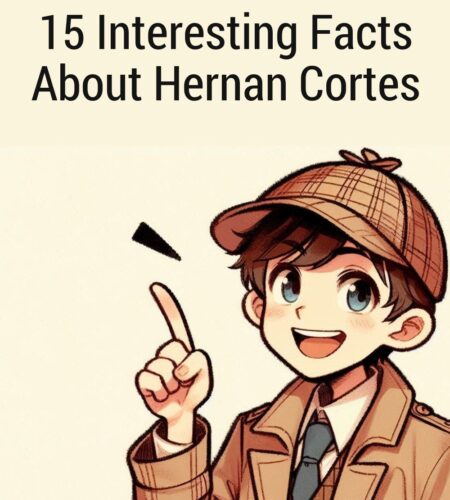Introduction:
Hernan Cortes is a name that continues to resonate through history as one of the most notable and controversial figures of the 16th century. Born in 1485 in Medellin, Spain, Cortes rose to prominence as the Spanish conquistador who led the expedition responsible for the conquest of the Aztec Empire in what is now known as Mexico. His actions and encounters during this expedition have been the subject of much fascination and discussion. In this article, we will delve into 15 interesting facts about Hernan Cortes, shedding light on his life, achievements, and legacy.
Fact 1: Hernan Cortes’ Early Life
Cortes hailed from a modest background, born into a family of lesser nobility. He received a good education and eventually decided to pursue a career in exploration and adventure. In 1504, he set sail to Santo Domingo, on Hispaniola, aiming to make a fortune in the newly discovered lands of the Americas.
Fact 2: The Encounter with the Aztecs
In 1519, Cortes led an expedition to present-day Mexico with the intention of exploring and colonizing the region. Upon arrival, he encountered the mighty Aztec Empire, led by Emperor Moctezuma II. This encounter marked the beginning of Cortes’ fascination with the Aztec civilization and his quest for their riches.
Fact 3: The City of Tenochtitlan
Cortes and his men were awestruck by the grandeur and complexity of the Aztec capital, Tenochtitlan. Built on an island in Lake Texcoco, it boasted magnificent temples, causeways, and bustling markets. Cortes later described it as surpassing any city in Europe in terms of size and organization.
Fact 4: The Myth of Quetzalcoatl
Cortes took advantage of the Aztecs’ belief in the return of their god Quetzalcoatl, whose appearance was prophesied to coincide with the arrival of bearded, light-skinned men. Taking advantage of this prophetic myth, Cortes presented himself as such a figure, creating confusion and fear among the Aztecs.
Fact 5: The Battle of Otumba
Cortes faced fierce opposition from various indigenous groups unwilling to submit to Spanish rule. The Battle of Otumba, fought in 1520, was a critical turning point. Despite being heavily outnumbered, Cortes and his small army emerged victorious, which helped solidify his presence in the region.
Fact 6: The Destruction of Tenochtitlan
In 1521, after a long and brutal siege, Cortes and his forces finally conquered Tenochtitlan, resulting in the fall of the Aztec Empire. The city was largely destroyed, and a new city, Mexico City, was established on its ruins, becoming the capital of New Spain.
Fact 7: The Aztec Gold
While the Aztecs left a lasting impression on Cortes with their advanced civilization, it was their reputed wealth in gold that drove his ambition. Cortes and his men looted vast amounts of gold from the Aztecs, contributing to Spain’s growing wealth and power at the time.
Fact 8: Cortes’ Complex Relationship with Emperor Charles V
Despite his accomplishments, Cortes’ relationship with Emperor Charles V was fraught with tension. The emperor, suspicious of Cortes’ growing influence, sought ways to curtail his power. Nevertheless, Cortes maintained favor with the Spanish court and was appointed the Governor and Captain General of New Spain.
Fact 9: Cortes’ Legacy in Mexico
Cortes’ conquest had a profound impact on Mexico’s indigenous populations, leading to the colonization and eventual integration of Spanish culture into Mexican society. Today, Mexico’s complex cultural heritage is a direct result of this encounter between Cortes and the Aztecs.
Fact 10: Cortes’ Search for El Dorado
Following his conquest of the Aztecs, Cortes became obsessed with the search for another legendary city rumored to be rich in gold. His relentless pursuit of the fabled El Dorado took him on various expeditions, notably to present-day Honduras and Baja California, but ultimately proved unsuccessful.
Fact 11: Cortes as a Landowner
With his acquired wealth and newfound status, Cortes purchased vast amounts of land in Mexico, becoming one of the largest landowners of his time. He established extensive agricultural enterprises, including sugar cane plantations and cattle ranches, which further contributed to his wealth and influence.
Fact 12: Cortes’ Retirement
After years of exploration and conquest, Cortes retired in 1547 and returned to Spain. Despite his numerous accomplishments, he faced legal battles and financial troubles in his later years, which somewhat tarnished his reputation and diminished his wealth.
Fact 13: Cortes’ Literary Contributions
During his retirement, Cortes penned several letters and documents detailing his expedition and the conquest of the Aztecs. These writings, known as the “Letters of Cortes,” provide invaluable firsthand accounts of the events and shed light on the cultural and historical aspects of the conquest.
Fact 14: Controversy Surrounding Cortes
Cortes’ actions in the conquest of the Aztec Empire have sparked ongoing debates about the ethics of colonization and the treatment of indigenous peoples. While viewed as a hero by some for his achievements, others condemn him for the violence, destruction, and diseases brought upon the native populations.
Fact 15: Cortes’ Enduring Legacy
Despite the controversy surrounding his legacy, Hernan Cortes remains a significant historical figure, emblematic of the Age of Exploration. His conquest of the Aztec Empire forever altered the course of history, shaping the destinies of both the Old and New Worlds and leaving an indelible mark on Mexico.
Conclusion
Hernan Cortes was a complex and enigmatic figure who navigated a world of conquest, wealth, and power. His encounter with the Aztecs and subsequent conquest of their empire have left an indelible mark on history. As we examine the 15 fascinating facts about Hernan Cortes, we come face to face with the triumphs, controversies, and enduring legacy of one of the most influential individuals of his time.
Subscribe to our email newsletter to get the latest posts delivered right to your email.





Comments